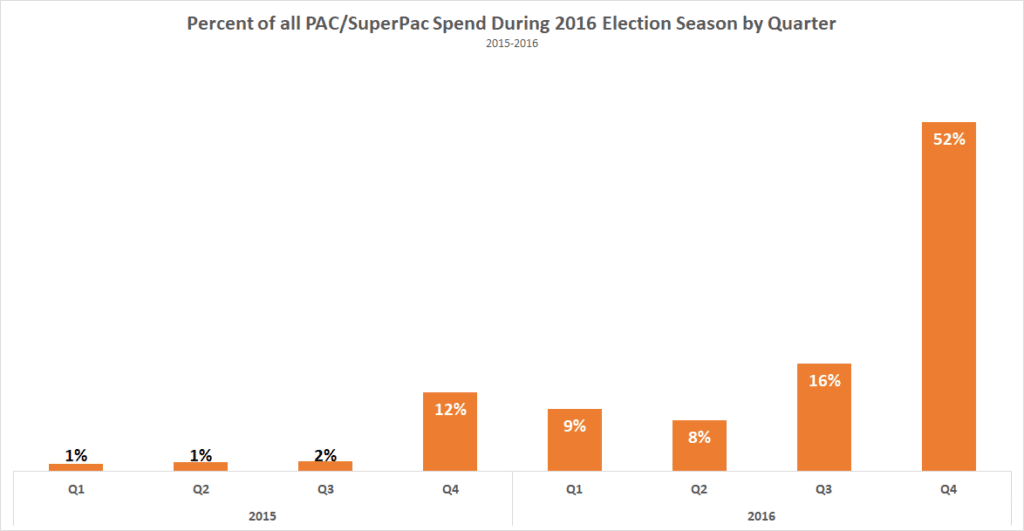Super Tuesday — the largest primary voting day in the 2020 election — is tomorrow.
While Super Tuesday may not reveal the Democratic nominee quite yet, it will be a sign of which advertising strategies are working.
All Democratic candidates, except the self-funded billionaires, have received money from outside groups.
PACs (political action committees) and super PACs have poured hundreds of millions of dollars into elections since the Supreme Court ruled in 2010 that corporations could spend all they wanted on political elections.
MediaRadar research found that PACs alone spent over $25M on ads during the 2016 election cycle.
Earlier this year, we looked at how programmatic ad spend represented a small portion of that spending.
Following up on that conversation, we wanted to explore how PACs and super PACs approach political advertising in election cycles at a broader level.

When do PACs and super PACs spend most on advertising?
PACs and super PACS have a lot at stake when it comes to political elections. No matter their interest — the environment, guns, or any ideology on the political spectrum — the one thing they do have in common is money.
PACs and super PAC spending starts almost two years before the presidential election, but it doesn’t intensify until the year of the vote.
The majority of the spending happens during the weeks leading up to the election.
If we look back to the 2016 election cycle (considered to be 2015 & 2016), over half of the ad spend from PACs and super PACS occurred in Q4 of 2016.

Roughly 16% of all spending took place in 2015. The remainder took place in 2016.
The election took place on November 8, 2016, so more than half of PAC spending took place between October and the first week of November. It was a huge final push.
Political advertising is already looking different in 2020. There are three billionaires in the race and a highly crowded democratic field. Only time will tell if PACs and super PACs feel more pressure to spend more earlier in the election cycle.
Where do PACS and super PACs place advertisements?
Where do these advertisements take place?
Looking at the couple of months leading up to the election, we can see where super PACs spent their ad dollars:
- 91% of spending went to TV
- The remaining 9% was split between digital ads (6%) and print ads (3%).
Where on TV did those advertisements get placed? In 2016, ads were placed mostly on networks with content that already aligned with the political goals of the PAC.
There were exceptions though.
For example, the DNC allocated about 10% of their tv ad budget to Fox. Likewise, the conservative Rebuilding America Now PAC allocated about 15% of their tv ad spend to MSNBC & CNN.
Who are the top spenders?
99% of all PAC spend comes from the top 10 spenders.
Four of the top PACs include:
- The Democratic National Committee (DNC)
- The House Majority PAC
- The Congressional Leadership Fund
- The NRA
What shape do super PAC ads take?
While super PACs essentially can spend all the money they want on ads, they are not allowed to coordinate with the official campaign. For this reason, the advertisement styles between super PACs and candidates differ.
“It’s not just more advertising that super PACs buy—it’s also a different kind of advertisement,” writes Idrees Kahloon at Harvard Magazine. Candidate-endorsed ads tend to be more positive, Super PAC ads tend to be more negative.
Official campaign ads must have the well known “I endorse this message” statement at the end of the ad. Super PAC ads do not have this statement.
PACs and super PACS extend their influence over American politics in significant ways — and their advertising money is only beginning to ramp up for the upcoming election.



